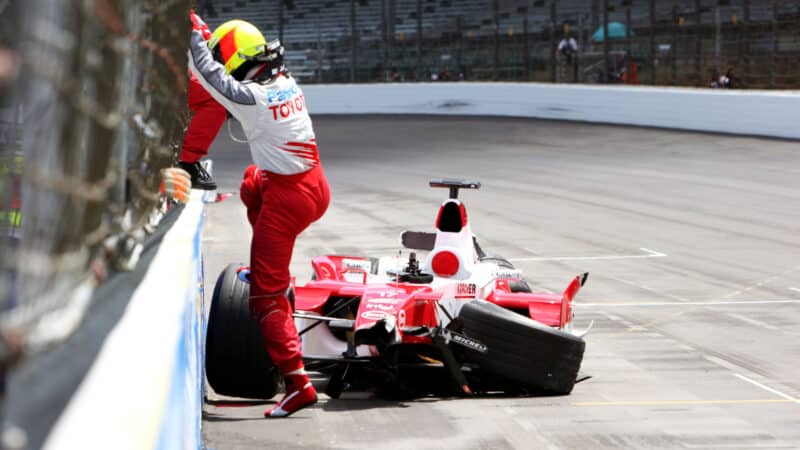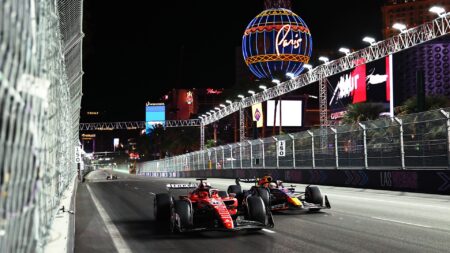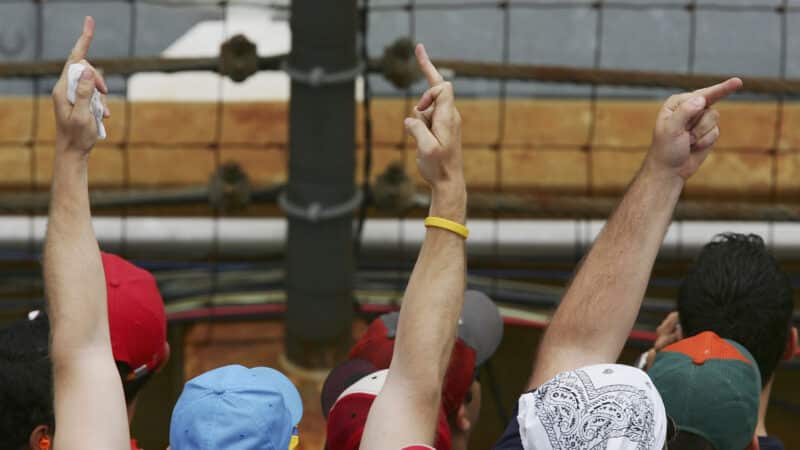How did that happen? OK, here goes. The version of the Indianapolis Motor Speedway then used by F1 was a 13-turn switchback made up of half the famous oval, encompassing two of its superfast banked turns, and an infield section consisting of 11 fiddly low- and medium-speed corners. As such, it was a tricky challenge for the teams’ and tyre companies’ engineers, and in 2005 the Michelin men got their sums wrong.
During Friday practice a number of the Michelin runners suffered left-rear tyre failures, after which, as a safety precaution, the company’s on-site engineers examined all the tyres that they had brought to the circuit. Faults were discovered with six tyres, and those six tyres were immediately flown back to Michelin’s Clermont-Ferrand (France) headquarters for further analysis. At first, a batch (i.e. manufacturing) problem was suspected – so, in order to provide a backup option, Michelin arranged for a shipment of Barcelona-spec tyres to be flown to Indianapolis. They arrived at 8.30am on Saturday.
That same morning, swapping and pooling gossip and rumours in the Indy media centre, we journalists learned that Michelin’s engineers in Clermont-Ferrand had been unable definitively to isolate a root cause of the failures that had occurred on track the day before, but we were given to understand that they suspected that the unusual lateral and vertical loadings induced by the high-speed running on the Brickyard’s famous banking, and particularly in Turn 13, had caused the Michelin left-rears to deform.
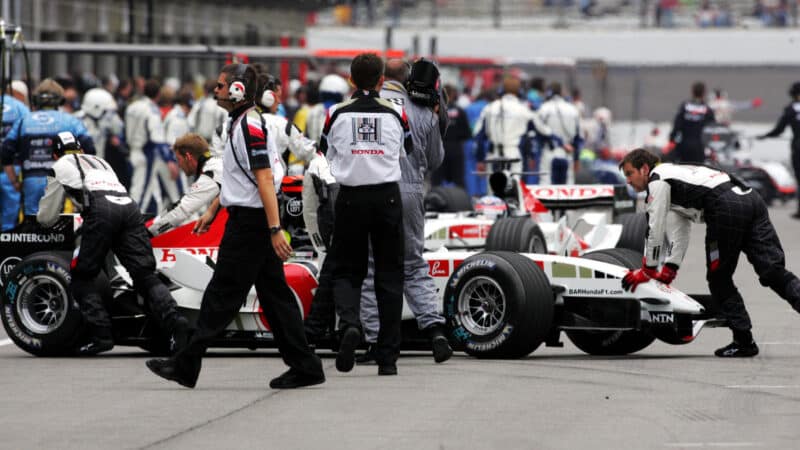
The Michelin runners driving into the pits right after the formation lap
Getty Images
As a result, Pierre Dupasquier (worldwide racing director, Michelin) instructed the seven Michelin-contracted teams to run no more than 10 cumulative laps per car in the two Saturday morning practice sessions. After those sessions, the tyres were taken off each Michelin-contracted car and flown to Michelin’s Lexington (South Carolina, USA) plant for yet more analysis.
Later, in qualifying that afternoon, each Michelin-tyred car successfully completed its one fast lap (i.e. three laps in total, comprising an out-lap, a flying lap, and an in-lap) since F1 qualifying was run as a single-lap shoot-out in 2005. The fastest four qualifiers were all Michelin runners – Jarno Trulli (Toyota) in pole position, followed by Kimi Räikkönen (McLaren), Jenson Button (BAR), and Giancarlo Fisichella (Renault).
After qualifying, all the left-rear Michelins that had been used in qualifying were flown to the Michelin facility in Akron (Ohio, USA) for final analysis, accompanied by FIA personnel tasked with making sure that parc fermé regulations were strictly adhered to. Meanwhile, news reached us that Michelin’s engineers in Clermont-Ferrand were now certain that Friday’s failures had indeed been related to the unusual lateral and vertical loadings induced by the banking at Turn 13.
Then, early on Sunday morning, it became clear that Michelin’s last get-out-of-jail-free card had disappeared, and the Michelin-contracted teams finally grasped that their tyre problem was a critical one. The reason was that, under further Turn 13 simulations conducted in both Akron and Clermont-Ferrand, Michelin’s left-rear tyres, including the Barcelona-spec left-rears, had all failed. So the only solution for the Michelin-contracted teams was either to withdraw from the event altogether, for safety reasons that would constitute force majeure, or to advise their drivers to race at reduced speed through Turn 13.
Clearly the former would be legally, contractually, and reputationally devastating for the entire F1 community, and the latter would not be workable. Senior people began to panic. Wild rumours started to circulate. Was there technology available via which a mandatory Turn 13 speed limit could be imposed on the Michelin runners? Could the Michelin runners be diverted down the pitlane on each lap, thereby avoiding Turn 13 altogether? Could a temporary chicane be placed immediately before Turn 13?
Of the above three suggestions, only a temporary chicane seemed to be (a) potentially safe and (b) even remotely feasible. Dupasquier supported the idea, as did the team principals and drivers of all the Michelin-contracted teams, as did Tony George (owner, Indianapolis Motor Speedway), and as indeed did Bernie Ecclestone. But Max Mosley, at home in Monaco, point-blank rejected the idea, his not unreasonable view being that it would be unfair on the teams supplied by Bridgestone, whose engineers had got their sums right.
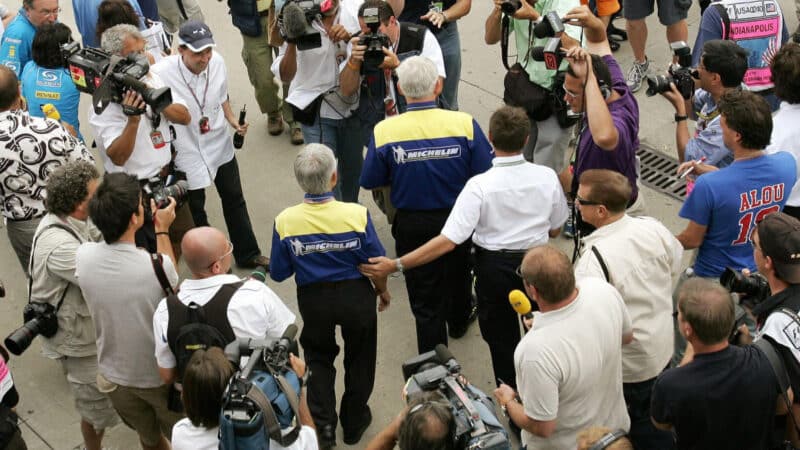
Michelin got the numbers wrong
Getty Images
That Sunday morning a febrile atmosphere began to develop in the F1 paddock. Ecclestone, George, McLaren‘s Ron Dennis, and Renault‘s Flavio Briatore all telephoned Mosley to beseech him to allow a temporary chicane to be built – even going so far as to suggest that no Michelin-contracted team be eligible to score world championship points in the interests of sporting equity.
I called Mosley, but unsurprisingly he did not pick up. A couple of days later I called him again. This time he picked up, and this is what he told me: “A temporary chicane would not have been part of the homologated circuit. It would not have gone through all the elaborate safety procedures we have nowadays – simulation, extrapolation, physical inspection, and so on. So, if there had been an accident – even one not directly related to the fact of the chicane – and someone had been injured or worse, then we [the FIA] would have been in an indefensible position in front of a United States court, because it could have been shown that we had not followed our own circuit-homologation procedures.”

